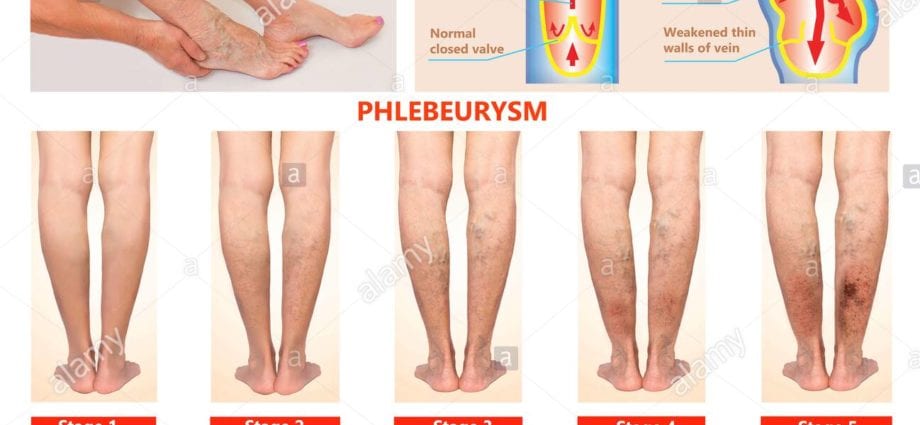Contents
General description of the disease
This is an inflammatory process that occurs in the walls of the veins on which a blood clot forms.
Causes of thrombophlebitis
The main reasons for the development of thrombophlebitis are any damage to the vein wall, even the most insignificant (for example, vein catheterization or vascular injury), a predisposition to the formation of blood clots of an acquired and hereditary nature, varicose veins, local or general inflammation.
The risk group for thrombophlebitis includes people who lead a sedentary lifestyle, are overweight, often travel for a long time by cars, airplanes, have just undergone surgery, an infectious disease or a stroke that led to paralysis of the lower extremities, people with cancer, dehydration, with increased blood clotting. Pregnant women, women who have just given birth or have had an abortion, women taking hormonal pills (including hormonal oral contraceptives) are at risk.
In most cases, thrombophlebitis develops against the background of varicose veins.
Thrombophlebitis symptoms
With thrombophlebitis of superficial veins, a slight pain appears in the skin at the location of the saphenous veins. The skin in the place where the blood clot formed on the vein wall becomes inflamed and turns red, when touched it is much warmer than the rest of the skin.
The body temperature rises to 37,5-38 degrees, but after 6-7 days, the body temperature returns to normal or stays at 37. With thrombophlebitis of the legs, the temperature, in most cases, does not rise.
The appearance of puffiness at the site of thrombus formation is a concomitant symptom.
With this disease, an inflammatory process passes through the veins, therefore, stripes of a red or bluish tint are formed along them on the skin. After that, seals begin to form, which are well felt (these are blood clots). The size of the seals depends on the diameter of the vein on the wall of which the thrombus has formed.
While walking, patients have severe pain.
Useful foods for thrombophlebitis
With this disease, adherence to a diet is shown, the principles of which are based on the normalization of blood flow, blood thinning, aimed at strengthening the venous walls and blood vessels.
To do this, you need to eat more fiber, drink enough liquid, eat fractionally, it is better to steam, boil or stew. Fried should be discarded.
To get rid of clots, you need to eat seafood, fish, beef liver, oatmeal and oatmeal, wheat germ, ginger, garlic, lemon, onion, herbs, citrus fruits, sea buckthorn, pineapples, watermelons, pumpkin and sesame seeds, all kinds of fruit drinks and juices from berries and fruits.
To replenish fluid in the body, you need to drink 2-2,5 liters of clean filtered water per day.
Traditional medicine for thrombophlebitis
For clogged veins:
- drink infusions of nettle, verbena officinalis, St. John’s wort, string, plantain, licorice root, cumin bark, white willow bark, rakita, willow, hop cones, hazelnut leaves, drink horse chestnut juice and drink nutmeg powder with water throughout the year ;
- rub their feet with alcoholic tincture of horse chestnut or white acacia, Kalanchoe juice, apply tomato slices to the sore spot, rub the legs with lilac leaves all night and bandage them with gauze, elastic bandage, apply wormwood leaves gruel to the veins;
- make baths with horse chestnut bark, oak bark, aspen, chamomile, nettle (baths need to be done only before bedtime, and the legs are tightly wrapped with a cloth or elastic bandage).
Traditional medicine for thrombophlebitis is only auxiliary in nature. Therefore, at the first sign of illness, you must seek medical help.
Dangerous and harmful foods for thrombophlebitis
- pork liver, lentils, beans, legumes, soybeans, green peas, watercress, broccoli, cabbage, currants, bananas, spinach (these foods contain vitamin K, which thickens the blood);
- fatty meats, rich broths, jellied meat, jelly, mayonnaise, sauces, sausages, canned food, smoked meats, confectionery and flour products, walnuts, margarine, instant food, chips (these products are rich in fat and carbohydrates that contribute to the formation blood clots, weaken the vein wall and help weight gain);
- alcoholic drinks and sweet soda;
- excessively salty food.
These foods should be eliminated from the diet. Their use can worsen the condition, especially during an exacerbation (in the summer, the blood is the most viscous and thickest). Reduce your coffee consumption to 2 cups per day. It is better to reduce the consumption of meat to 2 meals a week. Better yet, during treatment, replace meat with fish and seafood. Also, you should completely and permanently quit smoking.
Attention!
The administration is not responsible for any attempt to use the information provided, and does not guarantee that it will not harm you personally. The materials cannot be used to prescribe treatment and make a diagnosis. Always consult your specialist doctor!










